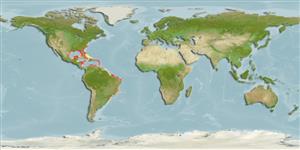>
Gobiiformes (Gobies) >
Gobiidae (Gobies) > Gobiinae
Etymology: Palatogobius: Latin, palatum = pertaining to palate and/or teeth + Latin, gobius = gudgeon (Ref. 45335).
Environment: milieu / climate zone / depth range / distribution range
Ecología
marino demersal; rango de profundidad 23 - 78 m (Ref. 92840). Tropical
Western Atlantic: northeastern Gulf of Mexico to Lesser Antilles.
Tamaño / Peso / Age
Maturity: Lm ? range ? - ? cm
Max length : 3.5 cm TL macho / no sexado; (Ref. 7251)
Short description
Morfología | Morfometría
Distinguished by the following characteristics: body with scales from the base of the caudal fin forward to the pectoral fin base; pelvic fins united but lack a frenum; most possess vomerine teeth (Ref. 92840).
Occurs in coral rubble and sand (Ref. 92840).
Life cycle and mating behavior
Madurez | Reproducción | Puesta | Huevos | Fecundidad | Larva
Robins, C.R. and G.C. Ray, 1986. A field guide to Atlantic coast fishes of North America. Houghton Mifflin Company, Boston, U.S.A. 354 p. (Ref. 7251)
IUCN Red List Status (Ref. 130435)
Threat to humans
Harmless
Human uses
Más información
Nombres comunesSinónimosMetabolismoDespredadoresEcotoxicologíaReproducciónMadurezPuestaAgregación para la puestaFecundidadHuevosEgg development
Age/SizeCrecimientoLength-weightLength-lengthLength-frequenciesMorfometríaMorfologíaLarvaDinámica larvariaReclutamientoAbundanciaBRUVS
ReferenciasAcuiculturaPerfil de acuiculturaRazasGenéticaElectrophoresesheritabilidadEnfermedadesProcesamientoNutrientsMass conversion
Herramientas
Special reports
Download XML
Fuentes de Internet
Estimates based on models
Preferred temperature (Ref.
123201): 19.6 - 27.6, mean 24.6 °C (based on 84 cells).
Phylogenetic diversity index (Ref.
82804): PD
50 = 0.7500 [Uniqueness, from 0.5 = low to 2.0 = high].
Bayesian length-weight: a=0.00708 (0.00333 - 0.01504), b=3.09 (2.92 - 3.26), in cm total length, based on LWR estimates for this (Sub)family-body shape (Ref.
93245).
Nivel trófico (Ref.
69278): 3.1 ±0.3 se; based on size and trophs of closest relatives
Resiliencia (Ref.
120179): Alto, población duplicada en un tiempo mínimo inferior a 15 meses (Preliminary K or Fecundity.).
Fishing Vulnerability (Ref.
59153): Low vulnerability (10 of 100).
